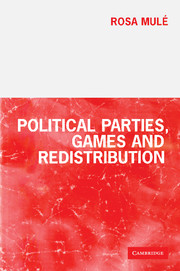Book contents
- Frontmatter
- Contents
- List of figures
- List of tables
- Acknowledgments
- Introduction
- 1 Political parties, games and income redistribution
- 2 Opposition effects, blackmail and u-turns under Pierre Elliot Trudeau
- 3 The arithmetics of politics under Margaret Thatcher
- 4 Right-wing ascendency, pivotal players and asymmetric power under Bob Hawke
- 5 The demise of the federal social safety net under Clinton
- 6 Conclusions
- Technical addendum
- Bibliography
- Index
5 - The demise of the federal social safety net under Clinton
Published online by Cambridge University Press: 22 September 2009
- Frontmatter
- Contents
- List of figures
- List of tables
- Acknowledgments
- Introduction
- 1 Political parties, games and income redistribution
- 2 Opposition effects, blackmail and u-turns under Pierre Elliot Trudeau
- 3 The arithmetics of politics under Margaret Thatcher
- 4 Right-wing ascendency, pivotal players and asymmetric power under Bob Hawke
- 5 The demise of the federal social safety net under Clinton
- 6 Conclusions
- Technical addendum
- Bibliography
- Index
Summary
POLITICAL BACKGROUND
This chapter examines the redistributive game that led to the demise of the Aid to Families with Dependent Children (AFDC) in 1996, the only US federal entitlement to the social safety net. For the first time since the New Deal no guaranteed help from the federal government exists for the poor, marking a break in the development of social legislation in the twentieth century (Weir, 1998). The Welfare Reform Act of 1996 was the culmination of the increasing polarisation of American politics around a left–right conflict. ‘This conflict is basically over income redistribution. Other dimensions of conflict, particularly race, have largely vanished as distinct lines of conflict because they have been incorporated into left–right or liberal–conservative conflict’ (McCarty, Poole and Howard, 1997: 1).
Redistributive issues were brought to centre stage in 1992 when Bill Clinton campaigned as a New Democrat and made welfare reform and comprehensive health reform the centrepiece of his political agenda. With this decision Clinton staked his domestic policy on two objectives which, in his strategic vision, would have crafted the new image of the Democratic Party. Work-for-welfare programmes could have helped President Clinton to establish credibility as someone willing to move beyond his party's New Deal socio-political coalition (Akard, 1998; Morley and Petras, 1998). Consequently, welfare reform became crucial for remoulding the party image.
- Type
- Chapter
- Information
- Political Parties, Games and Redistribution , pp. 158 - 180Publisher: Cambridge University PressPrint publication year: 2001



